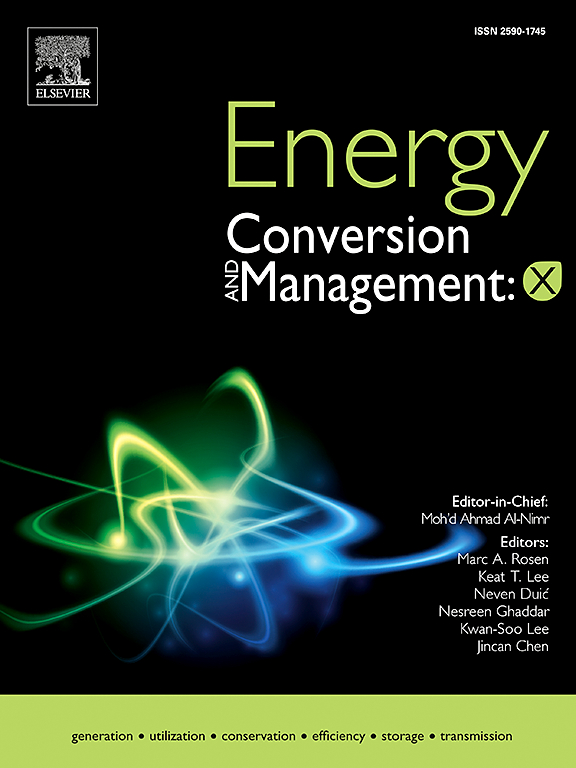使用传统燃料和甲醇的海洋运输的生命周期温室气体排放和成本
IF 7.1
Q1 ENERGY & FUELS
引用次数: 0
摘要
在本研究中,与传统的化石燃料相比,评估了可再生甲醇作为SUEZMAX油轮的低碳强度燃料的生产和使用,用于从沙特阿拉伯到亚洲(日本)和欧洲(荷兰)的能源运输。在这三个地区,基于可再生能源的甲醇生产已经建立了模型,利用太阳能或风能生产氢气,以及从每个地区相关来源捕获的二氧化碳(CO2)。对SUEZMAX油轮使用可再生甲醇、天然气甲醇、液化天然气(LNG)、极低硫燃料油和高硫燃料油的两种类型的行程进行了井到尾生命周期温室气体排放分析和生命周期成本分析。根据三个地区可再生能源的年度变化,通过改变制氢的成本和碳强度,以及改变每个地区用于生产可再生甲醇的二氧化碳捕获源,进行了敏感性分析。使用生命周期成本(3.99亿至9.21亿美元)和生命周期排放(50万至210万公吨)的敏感性分析结果来评估碳减排成本,当假设氢成本为1美元/千克时,观察到碳减排成本最低(每公吨二氧化碳3至12美元)。在研究的三个地区中,沙特阿拉伯是可再生甲醇生产的地点,其生命周期排放量(50至80万吨)和成本(5.88至5.97亿美元)最低,而欧洲被证明是可再生甲醇生产的下一个最具成本效益的地区。本文章由计算机程序翻译,如有差异,请以英文原文为准。
Life cycle greenhouse gas emissions and cost of marine transport with conventional fuels and methanol
In this study, the production and use of renewable-based methanol as a low carbon intensity fuel for a SUEZMAX tanker is evaluated for energy transport from Saudi Arabia to Asia (Japan) and Europe (the Netherlands), in comparison to the conventional fossil-based fuels. Renewable-based methanol production has been modeled in all three regions from hydrogen, produced with solar or wind energy, and carbon dioxide (CO2) captured from sources relevant to each region. The Well-to-Wake life cycle GHG emissions analysis and life cycle cost analysis was performed for the two types of trips of the SUEZMAX tanker operating on renewable-based methanol, natural gas-based methanol, liquefied natural gas (LNG), very low sulfur fuel oil and high sulfur fuel oil. A sensitivity analysis was performed by varying the cost and carbon intensity of hydrogen production based on annual variation in renewable energy in the three regions, as well as changing the source for CO2 captured to produce renewable-based methanol in each region. Sensitivity analysis results for life cycle cost (399 to 921 million US dollars) and life cycle emissions (0.5 to 2.1 million metric tonnes) were used to evaluate the cost of carbon abatement, which was observed to be the lowest (3 to 12 US dollar per metric tonne of CO2) when the hydrogen cost was assumed to be $1/kg. Of the three regions examined, Saudi Arabia was the location for renewable-based methanol production with lowest life cycle emissions (0.5 to 0.8 million metric tonnes) and cost (588 to 597 million US dollars), while Europe was shown to be the next most cost-effective region for renewable-based methanol production.
求助全文
通过发布文献求助,成功后即可免费获取论文全文。
去求助
来源期刊

Energy Conversion and Management-X
Multiple-
CiteScore
8.80
自引率
3.20%
发文量
180
审稿时长
58 days
期刊介绍:
Energy Conversion and Management: X is the open access extension of the reputable journal Energy Conversion and Management, serving as a platform for interdisciplinary research on a wide array of critical energy subjects. The journal is dedicated to publishing original contributions and in-depth technical review articles that present groundbreaking research on topics spanning energy generation, utilization, conversion, storage, transmission, conservation, management, and sustainability.
The scope of Energy Conversion and Management: X encompasses various forms of energy, including mechanical, thermal, nuclear, chemical, electromagnetic, magnetic, and electric energy. It addresses all known energy resources, highlighting both conventional sources like fossil fuels and nuclear power, as well as renewable resources such as solar, biomass, hydro, wind, geothermal, and ocean energy.
 求助内容:
求助内容: 应助结果提醒方式:
应助结果提醒方式:


